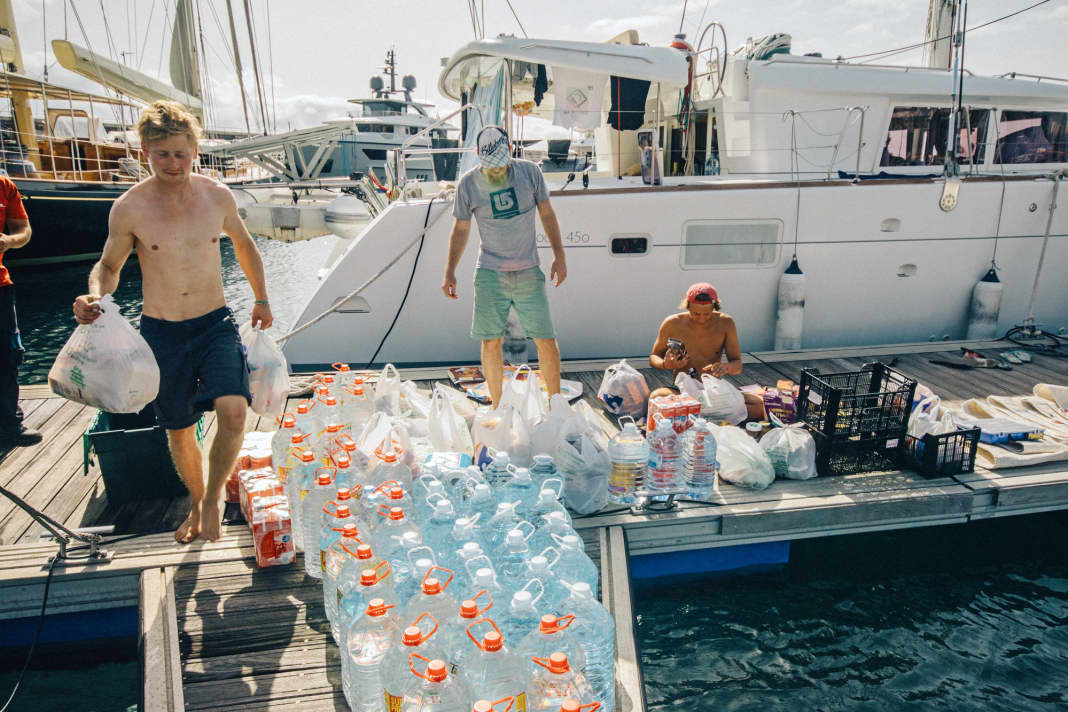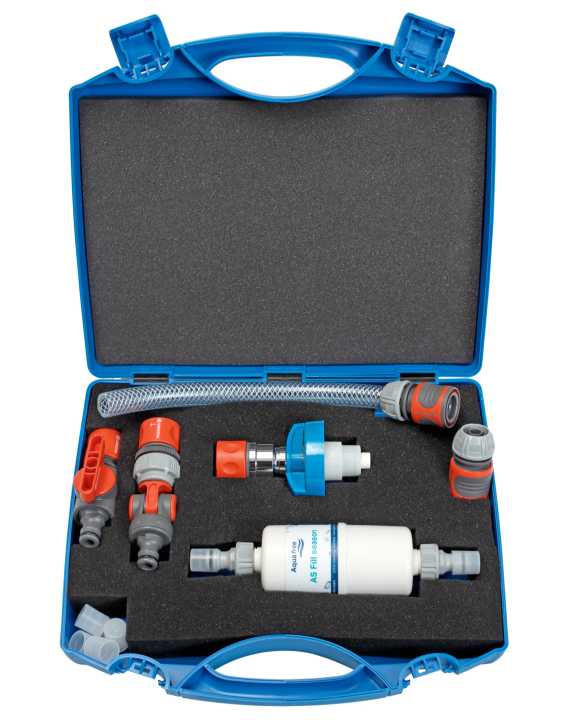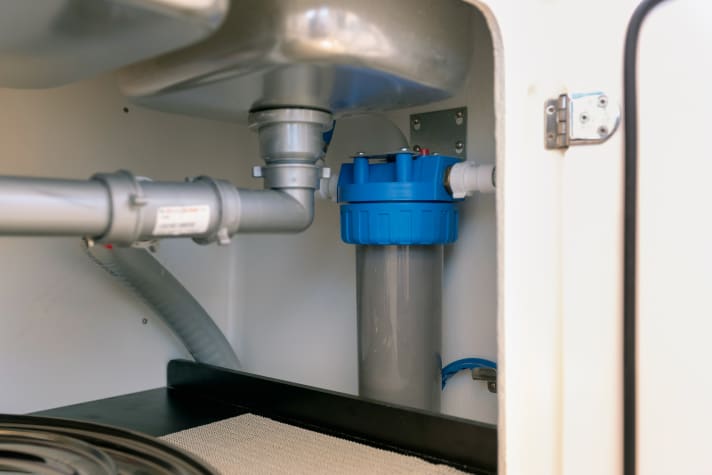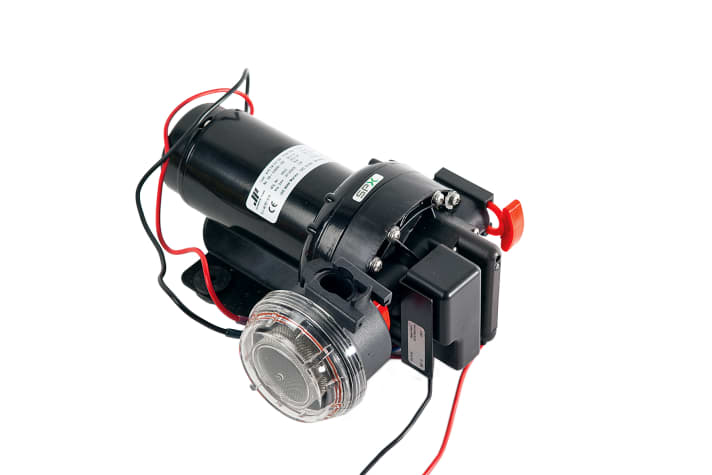Drinking water on board: You can filter water correctly using these methods






It's not just the crews of charter yachts who often lug loads of water bottles on board. Many owners also don't trust the quality of the water in their tanks. In fact, it is often poor. In most cases, the tank water does not smell particularly good; the flavour fluctuates between stale and chemical. This is due to the system: contaminated water can get into the tank during filling if the pipes on the bridge and the hose on the tap are unsuitable or old. What's more, you never know whether your neighbour on the jetty might have flushed their blocked waste tank and pushed the drinking water hose a little too far into the suction opening.
After filling, the water then stands in the tank for a long time. These are ideal conditions for organisms to multiply, especially in summer when temperatures are high. A slimy biofilm forms on the tank walls and in the pipes, in which bacteria colonise. The organisms in the water do not have to be directly dangerous. However, there is a risk that pathogenic germs, i.e. organisms with disease-causing properties, such as faecal bacteria or legionella, may also colonise. The latter often occur in tank water and are less dangerous if the water is drunk. It becomes problematic when showering, as they can enter the lungs in small droplets and cause pneumonia in people with a weak immune system, for example.
Clean water in the tank is a prerequisite
The most important prerequisite for ensuring that drinkable water comes out of the tap on board is that clean water is filled into the tank. In addition, the tank and pipes must be as free of organisms as possible. And it is advisable to filter the water before drinking.
Jeanneau had already installed a sterile filter element concealed under the sink as standard on the Sun Loft 47 in 2019. The shipyard wanted to save sailors the hassle of lugging around water bottles. Such inline filters, which are integrated into the pipe, use a special membrane to retain particles from the liquid that are well below one micrometre in size - i.e. less than a millionth of a metre.
Most boat accessory dealers also have filters on offer. However, these are almost always either very coarse filter elements made of polypropylene fibres or with activated carbon. These can only filter sand, limescale particles or other large suspended particles from the water, but bacteria can pass through unhindered. This is why such filters must be used in conjunction with chemical cleaning of the tank water. The advantages of sterile filtration over treating the water with chemicals are greater safety and less environmental pollution. In addition, most additives result in a peculiar flavour.
Methods for filtering tank water
In order to use a sterile filter on board, certain requirements must be met. Ideally, it should be installed directly under the tap. However, a separate filter would then have to be installed at each tap in the galley and in the toilet rooms, which is inconvenient and expensive. A good alternative is to install the filter behind the pressurised water pump as seen from the tank. In this way, filtered water is supplied to all taps and in the shower. However, there is still a risk of contamination in the pipes behind the filter.
A powerful pump is also important, as the filter represents a considerable resistance. Pumps that can handle pressures of up to three bar are ideal. Pipes and connections must of course be able to withstand the higher pressure.
The ideal solution is a combination of a thoroughly cleaned tank and a pipe system into which clean water is already stored via a filling filter that can be connected to the hose on the bridge. This is automatically cleaned again by a sterile filter in the pipe before use - when the tap is turned on. To ensure that there are no legionella bacteria in the water vapour when showering, for example, there are also special shower heads with an integrated filter in the handle. Here too, sufficient pressure is a prerequisite for proper functioning.
Some systems combine sterile and activated carbon filters. In this case, the activated carbon filter must be positioned in front of the sterile filter so that the coarser suspended particles are trapped first. In addition, the number of germs behind the activated carbon filter may well be higher than in front of it, and it is precisely these that the sterile filter then filters out of the water.
The Hamburg-based company Aqua free offers sterile filter systems not only for the medical sector, but also for use in boats: the AS-Fill-Season-Basic-Set is specially designed for filtering when filling the tank. The filter element is supplied in a case with suitable Gardena connections and costs 149 euros. The replacement filter - which must be changed annually - costs 80 euros. The AS Tube, a sterile filter container for installation in the water pipe, also costs 149 euros and the associated filter, which has to be changed annually, costs 80 euros. This means that Aqua free products require an investment of almost 380 euros to clean the tank water when filling it and before it is drawn from the tap; in the following season, new filters cost 160 euros. If you also want to retrofit the shower with a legionella filter, you will need to budget for an additional 85 euros. There may also be additional costs of around 300 to 400 euros for a more powerful pressurised water pump.
All in all, this is quite costly, but a worthwhile investment in the long term, especially from an ecological point of view.
Methods for filtering tank water
With pressure through the membrane
The sterile filters are designed for the treatment of drinking water. They cannot be used to purify rainwater or river water, as the membrane would quickly become clogged
A clean start

With the AS Fill Season basic set from Aqua free, the water is filtered during bunkering. Gardena adapters for the hose are included. Price: 149 euros one-off for the set, 80 euros per year for the replacement filter.
- Further information: www.aqua-free.com
From the tank into the glass

A sterile filter is installed under the sink on the Jeanneau Sun Loft 47. This means that the tank water is safe to drink and charter guests no longer have to carry PET bottles.
Put pressure on

The water filter with its membrane represents a considerable resistance. The pump must therefore generate sufficiently high pressure. The test winner from YACHT 6/2014, the Aquajet Flowmaster 5.0 from Johnson (price: approx. 360 euros), manages this without any problems.
With or without coal?

Although activated charcoal filters can filter out larger particles and bad flavours, they cannot filter out bacteria. In fact, the carbon can even help the organisms to multiply.
Further topics in the sustainability special:
- 25 tips to help you sail more environmentally friendly
- These projects are available for marine conservation
- Sailing yacht vs. motorboat: which model is more sustainable?
- Boatbuilding ecolution: These shipyards are working on sustainable concepts
- Shipyard portrait Greenboats: Boats made of flax and components for Boris Herrmann
- Sustainable fashion: oilskins and other functional clothing - the best products
- Sail recycling: not just stylish bags - what happens to old cloth
- Boat recycling: the never-ending story of GRP
- "Losing is not an option" - Boris Herrmann on sustainability in motorsport
- Sustainable management: Wooden boats in charter operations
- Equipment: Every sailor should reach for these green alternatives
- Baltic Sea: How does a harbour become sustainable?
- Research yachts: Climate protectors under sail
- Pallets, bottles, flip-flops: creative recycling ideas in boatbuilding
- Monsoon 31: Greenfit instead of refit, what does that mean for the 50-year-old Hallberg-Rassy?
- "Nomade des Mers": a catamaran as a low-tech laboratory
- Self-build yacht "Ya": Totally self-sufficient on a trip around the world
- Sustainable boat project: 55-foot catamaran made from recycled aluminium
- The Schwörer family and the "Pachamama": on a long voyage for climate protection
- Nike Steiger on her recycling project

